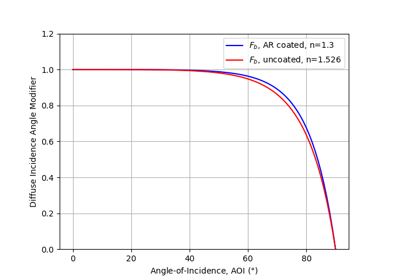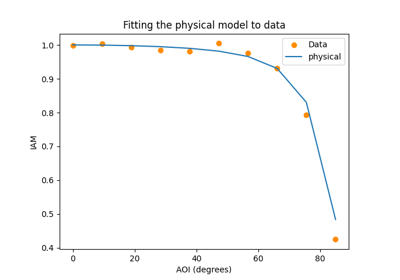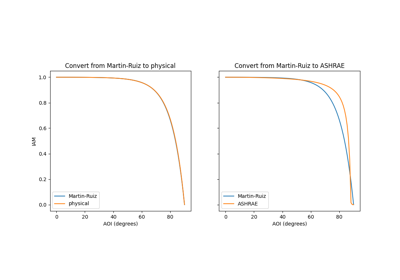pvlib.iam.physical#
- pvlib.iam.physical(aoi, n=1.526, K=4.0, L=0.002, *, n_ar=None)[source]#
Determine the incidence angle modifier using refractive index
n, extinction coefficientK, glazing thicknessLand refractive indexn_arof an optional anti-reflective coating.iam.physicalcalculates the incidence angle modifier as described in [1], Section 3, with additional support of an anti-reflective coating. The calculation is based on a physical model of reflections, absorption, and transmission through a transparent cover.- Parameters:
aoi (numeric) – The angle of incidence between the module normal vector and the sun-beam vector in degrees. Angles of nan will result in nan.
n (numeric, default 1.526) – The effective index of refraction (unitless). Reference [1] indicates that a value of 1.526 is acceptable for glass.
K (numeric, default 4.0) – The glazing extinction coefficient in units of 1/meters. Reference [1] indicates that a value of 4 is reasonable for “water white” glass.
L (numeric, default 0.002) – The glazing thickness in units of meters. Reference [1] indicates that 0.002 meters (2 mm) is reasonable for most glass-covered PV panels.
n_ar (numeric, optional) – The effective index of refraction of the anti-reflective (AR) coating (unitless). If
n_aris not supplied, no AR coating is applied. A typical value for the effective index of an AR coating is 1.29.
- Returns:
iam (numeric) – The incident angle modifier
Notes
The pvlib python authors believe that Eqn. 14 in [1] is incorrect, which presents \(\theta_{r} = \arcsin(n \sin(AOI))\). Here, \(\theta_{r} = \arcsin(1/n \times \sin(AOI))\)
References



